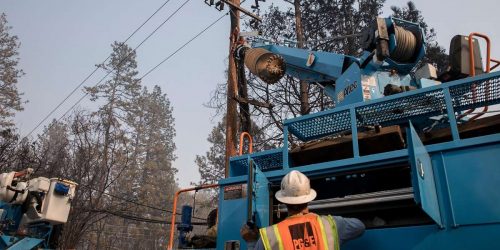California’s energy-grid operator imposed rolling blackouts Friday evening for the first time in 19 years.
With the rare move, the California Independent System Operator sought to preserve the stability of the system that provides power for tens of millions of residents and businesses. The last time grid managers implemented this kind of power cut was in 2001, when the state was in the throes of an electricity crisis.
The effect was felt promptly in Northern California, as Pacific Gas and Electric Co. began shutting off power to large blocks of customers for up to an hour at a time. In a news release, the utility said that each rotating block of blackouts could affect up to 250,000 customers.
An online map provided by PG&E showed outages across the Bay Area, but by early evening, San Rafael and nearby areas appeared to be hardest-hit, with more than 48,000 customers out of power. Other cities, including San Francisco, San Jose and Vallejo, also saw significant outages, though it was not clear if all were linked to the rotating power cuts.
Shortly after 9 p.m., PG&E said it would impose no more blackouts for the evening, and crews began restoring power.
The agency, which manages most of the state’s electrical grid, had earlier asked residents to not use major appliances between 3 and 10 p.m. Friday. Managers urged people to turn off unnecessary lights and set air conditioners to no lower than 78 degrees if possible, in the hopes of staving off the sweeping power outages. The blackouts ended up being required anyway.
Grid managers may issue additional requests to lower electrical usage as the heat wave continues into next week.
In recent days, the system operator had tried to seek additional energy supplies from the market as forecasts indicated a far-reaching heat wave was in store, spokeswoman Anne Gonzales said.
“That has not materialized, and we think it’s probably due to the widespread heat wave that’s occurring across the western U.S.,” Gonzales said. “We used all the tools we have to stimulate supply. Now it’s up to demand.”
The spike in electricity use is caused in large part by home air conditioners in the hottest areas of California, including parts of the the Bay Area.
The prolonged nature of the heat wave adds another challenge.
“The buildings don’t have a chance to cool down. The infrastructure doesn’t cool off. People are not getting that nighttime cooling relief,” Gonzales said. “It just means that air conditioners have to work harder and longer to cool spaces.”
Cloud cover also reduced some of California’s ability to generate power from solar panels, further constraining the grid, Gonzales said.
Even though California recently entered the most dangerous stretch of its wildfire season, PG&E does not currently intend to intentionally turn off power to prevent more blazes in the coming days.
PG&E power lines have started major infernos in recent years, including the state’s deadliest and most destructive wildfire on record in 2018. The company has turned to forced blackouts as a way of preventing more disasters during dry, windy weather that knock vegetation into power lines or break critical pieces off high-voltage electric equipment.
The current danger, by contrast, is that some homes could lose power if electrical equipment buckles amid prolonged high temperatures.
“We refer to this type of weather as a heat storm, much as we would refer to heavy rain and winds during the winter as a winter storm,” said PG&E spokesman Jeff Smith.
Just as high winds and rain can knock down power lines and cause outages, so too can intense heat — especially when it lasts for days — break PG&E equipment, Smith said.
That may prove particularly true in communities where the grid was not designed with sustained heat waves in mind, unlike in the Central Valley, where temperatures often linger in the triple digits this time of year.
To help ease burden on the grid, PG&E encouraged residents to draw their drapes, unplug phone chargers and power strips and, for those who have pools, to have their pumps run overnight. Frozen bottled water can also come in handy to help refrigerated food last longer if the power goes out, Smith said.







